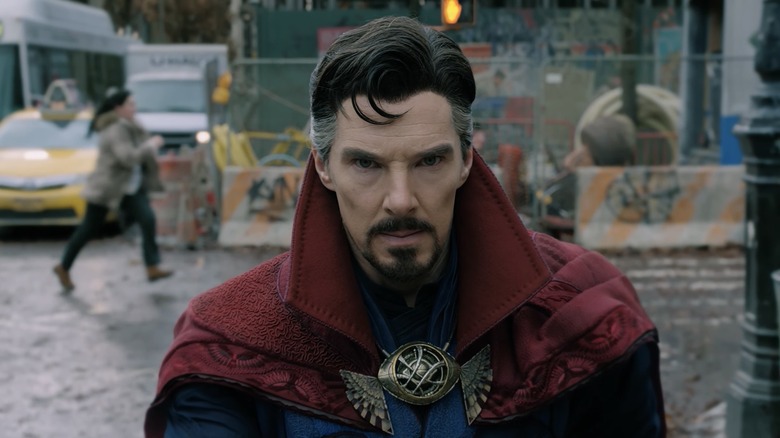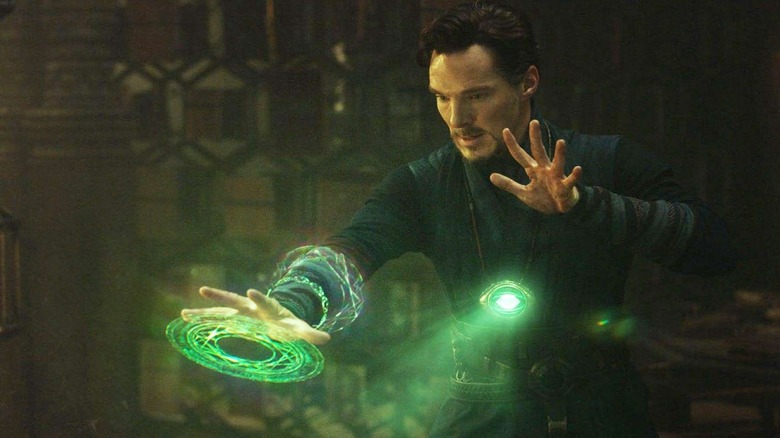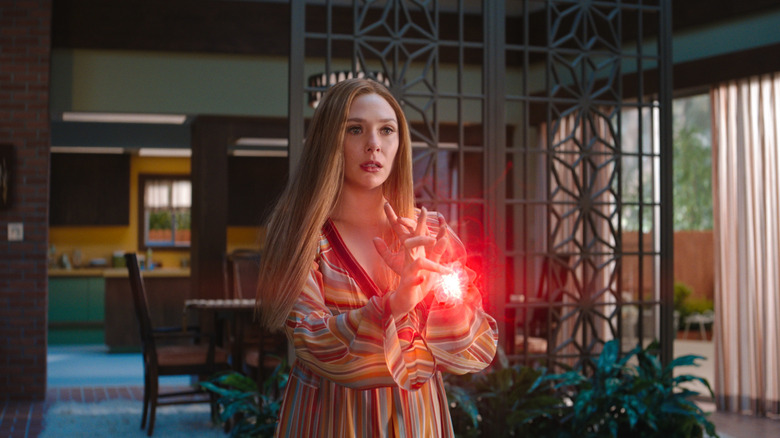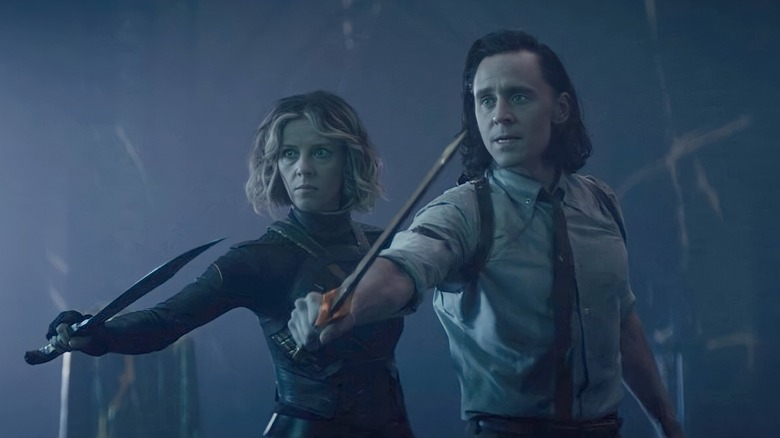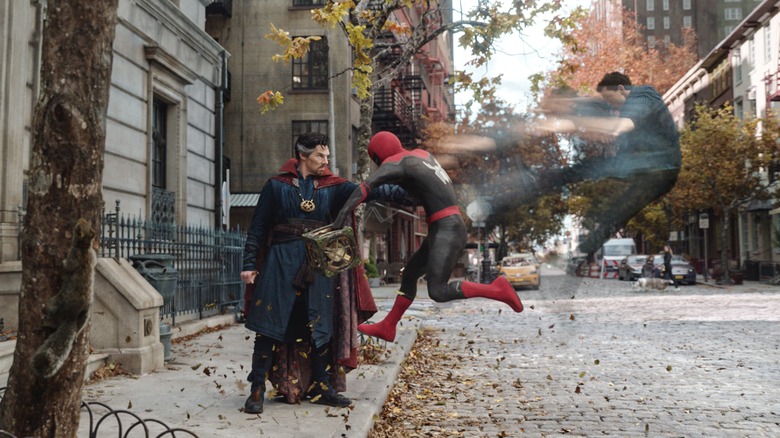What Non-Marvel Fans Need To Know To Watch Doctor Strange In The Multiverse Of Madness
Look, I get it. Even us self-professed pop culture junkies would have to admit that we're currently drowning in an ocean of capital-C Content, struggling to keep our heads above water while new movies and shows — all of which are seemingly billed as must-watch material — debut on a weekly basis. There's only so much we can do to stay up-to-date with this overwhelming and intimidating over-saturation, which certainly explains the need for vigilance in keeping track of all the quality media that tends to slide right under our radar. With so much stuff clamoring for our attention at any given moment, it's probably inevitable that even a franchise as popular as the Marvel Cinematic Universe would end up a casualty of this phenomenon. After all, unless you've been meticulously following every installment of the series since 2008 through multiple mediums (which really isn't as much of a given as those of us who are Extremely Online might expect!), who has time to embark on a marathon of such a sprawling and interconnected universe?
With "Doctor Strange in the Multiverse of Madness" arriving in theaters today, there's bound to be some confusion over exactly which prior entries in the MCU are required viewing in order to make sense of this latest sequel. Previously, the straightforward answer would probably have been "none," as earlier installments have gone to great lengths to make each respective plot understandable to newcomers. But with so many hours of storytelling under their belt now, the events of entire movies have had to become relegated to one-off references in an effort to keep the current plot moving forward.
Luckily, that's where this handy guide comes in. Join me as we play a quick game of catch-up on everything you need to know before watching "Doctor Strange in the Multiverse of Madness."
Doctor Strange (2016)
Might as well start at the beginning, right? Horror director Scott Derrickson and writer C. Robert Cargill were originally tasked with introducing audiences to the comic book character of Stephen Strange. The origin story quickly establishes all of the basics we need to know about this character: his insufferable selfishness, casual cruelty, and his brilliance as a neurosurgeon. In a sequence that doubles as one of the MCU's most uncomfortably real PSAs about the dangers of texting while driving (I am duty-bound to note that this meme has enjoyed a terrifically long shelf life), Strange ends up totaling his car and losing the most important thing to him in his entire career: the use of his incredibly skilled hands.
Much of the early portions of "Doctor Strange" cover his frantic efforts to find some sort of a cure, exhausting his considerable wealth on countless surgeries and leaving him destitute. Alone and at the end of his rope, his toxic personality and self-absorption having done considerably more damage than the car accident ever could (including costing him his already-strained relationship with fellow doctor Christine Palmer, played by Rachel McAdams), Strange ultimately finds himself at the door of Kamar-Taj — the secretive yet highly powerful cabal of wizards and magic-users who hold the key to unlocking the full potential of the "Mystic Arts." Here, we're also introduced to several key supporting characters who go on to play important roles throughout the MCU: sorcerer Karl Mordo (Chiwetel Ejiofor), humble librarian Wong (Benedict Wong), and the then-current Sorcerer Supreme, known only as The Ancient One (Tilda Swinton). Under her guidance, Strange finds out that the world of the MCU is merely one of an infinite amount of universes in existence, with beings in other multiverses constantly threatening to overwhelm their own. That's where the Sorcerer Supreme comes in, the chosen protector of reality as we know it.
Rather than wax poetic about my own thoughts on this underrated film (I'll simply let /Film's Siddhant Adlakha do so), it's simply worth knowing that "Doctor Strange" laid a solid foundation for the character's continued presence in the MCU. Raimi himself credited Derrickson's work for serving as a jumping-off point to everything that "Multiverse of Madness" eventually did. From less-than-humble beginnings to Sorcerer Supreme, "Doctor Strange" deserves credit for turning an arrogant Tony Stark-like jerk into another fan-favorite member of the Avengers.
WandaVision
Not subscribed to Disney+ or simply a little out of the loop when it comes to all these new Marvel shows? Not to worry! The MCU's first real attempt at actual, cross-platform interconnectivity came about with the 2021 premiere of "WandaVision." The main appeal of this series, at least in the early stages, involved serving as an homage to each decade of classic television. This genuinely unique and creative structure allowed the writing team (led by creator Jac Schaeffer) to incorporate this loving ode with the ongoing misadventures of Wanda Maximoff (Elizabeth Olsen), the Avenger also known as the Scarlet Witch. Little did we know just how important this series would prove to be in the long run.
Picking up after the events of "Avengers: Infinity War" and "Avengers: Endgame," "WandaVision" drops us into the oddly black-and-white reality sitcom television. Here, Wanda takes on the role of a typical housewife and reunited with the android Vision (Paul Bettany), Wanda's lover who was heartbreakingly killed during "Infinity War." It soon becomes clear that this idyllic fantasy of a simple life with a husband and two kids is just that — a fantasy, created by the incredibly powerful Wanda to help her cope with her grief. This becomes our first real indication of Wanda's slide towards villainy, as we find out that this illusion comes at the cost of essentially enslaving the minds of all the inhabitants residing in Westview, New Jersey, to act out this fantasy with her.
With Wanda featuring prominently in the marketing for "Doctor Strange in the Multiverse of Madness," a basic knowledge of the events that unfold in "WandaVision" would definitely provide some crucial context. The nine-episode series eventually culminates in Wanda fighting another witch, Agatha Harkness (Kathryn Hahn), who taps into incredibly dark powers for her own sinister agenda through the use of an ancient evil tome called the Darkhold. Ultimately recognizing the error of her ways, Wanda frees the town, says her tearful goodbyes to her conjured family, and banishes herself to a remote location ... though now armed with the Darkhold herself and some still-unresolved feelings of grief for her lost "children."
Loki
Still with me so far? Good, because this is where things get slightly more confusing.
One might not think that a Disney+ series about the God of Mischief, the brother of Thor, and the main villain of 2012's "The Avengers" would have much to do with the next "Doctor Strange" movie, but this is the MCU we're talking about, after all. The first wrinkle has to do with the fact that this version of Loki (Tom Hiddleston) isn't even the same Loki we knew from the movies, who was killed by the evil Thanos (Josh Brolin) early on in "Avengers: Infinity War." No, "Loki" is actually a spin-off from a loose thread from "Avengers: Endgame," in which some time travel hijinks leads to a version of Loki from "The Avengers" escaping his timeline and ending up caught by the Time Variance Authority — more or less interdimensional cops. Yep, you can consider this our second major MCU project dedicated to the mysteries of the multiverse.
Though the nitty-gritty particulars of the series aren't necessary for understanding "Doctor Strange in the Multiverse of Madness," the overall concepts introduced and further explained in "Loki" do play a significant role. Pressed into duty to hunt down one of his own "variants" (a word for other versions of himself causing multiversal mischief with the course of the "Sacred Timeline"), Loki must crisscross countless universes and realities on the hunt for a female version of himself — Sylvie (Sophia Di Martino). The pair eventually team up and uncover a vast conspiracy at the heart of the TVA, turning them both into fugitives and finally leading them to the man behind the curtain. The season finale introduces Jonathan Majors' Kang, a major multiverse-crossing figure who will become the next Thanos-level threat in the MCU.
As recently confirmed by Kevin Feige himself, the choice that Kang presents to Loki and Sylvie has had direct reverberations on the direction the rest of the MCU has taken. They can peacefully take over his job as the main overseer of the multiverse, or kill him and unleash ... well, madness. The ever-impulsive Sylvie chooses the latter, of course, and causes the "Sacred Timeline" to split off into endless branches of chaos. If "Doctor Strange in the Multiverse of Madness" is any indication, it certainly seems as if that one act will have many, many consequences to come.
Spider-Man: No Way Home
Back to the big screen!
After a brief detour into crossover land with "Infinity War" and "Endgame," Doctor Strange finally returns to co-star opposite Tom Holland in "Spider-Man: No Way Home." The threequel follows Peter Parker in the aftermath of the events of "Spider-Man: Far From Home," which resulted in his secret identity as Spider-Man leaking to the entire world. In the face of all the complications this causes, Peter turns to the one magic-wielding sorcerer that he knows: Doctor Strange. Upon learning of a spell that could cause the whole world to forget that Peter Parker is the masked webslinger... Well, let's just say that this misguided attempt at a quick fix causes a lot more trouble than it's worth.
With regards to "Doctor Strange in the Multiverse of Madness," the key takeaway from "No Way Home" concerns the most dramatic example of the multiverse concept yet. The spell gone haywire causes an interdimensional rift, allowing villains from otherwise unrelated "Spider-Man" movies in years past (two directed by Marc Webb, and the other three directed, ironically, by Sam Raimi) to invade the universe of our Marvel heroes. The film is mostly preoccupied with how Peter and his friends react to these threats versus how Strange does. Having seen the damage that villains can wreak, Strange coldheartedly condemns these villainous intruders to death for the greater good. Our friendly neighborhood Spider-Man, on the other hand, believes in their possible redemption.
This conflict between heroes gives us plenty of universe-hopping spectacle as the two, ah, aggressively work out their professional differences. But ultimately, Doctor Strange returns in the climactic third act battle to help prevent the villains from creating a total breakdown of the multiverse. This is only narrowly achieved with one final attempt of the memory-erasing spell, this time allowing all those Spidey villains to return to their own realities but causing Strange (along with the rest of the world) to forget who Peter Parker is. Everyone goes their separate ways, leaving us with a deeper exploration into the multiverse.
Eagle-eyed fans may catch even nerdier Easter eggs and connections in "Doctor Strange in the Multiverse of Madness," which picks up directly after these events. The rest of us, however, can rest assured that we're going into the sequel armed with everything we need to know to make sense of the multiverse.
